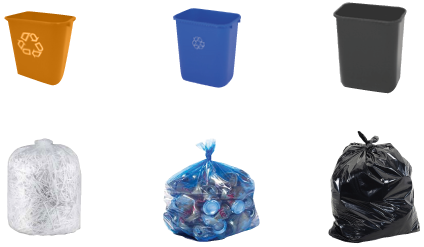10 Ways TO Enhance Your Recycling Program
Whether your business is new to recycling, or you consider your company to be expert recyclers, we find that business owners, managers and Eco-Ambassadors alike usually welcome helpful recycling tips with open arms. Whichever end of the spectrum you believe your business falls on, we're providing you with 10 useful tips for enhancing your recycling program:
1. elect eco-ambassadors or A green team
Every successful recycling program begins with enthusiastic Green Champions / Eco-Ambassadors! If you don't have one already, a group of 4-7 driven employees is all it takes to monitor and enhance the recycling program. The team will be responsible for overseeing the program, brainstorming new initiatives, setting new goals, spreading awareness, building habits, and tracking the success of the program. If you're motivated to make organizational change or generally have recycling on the brain, then this position may be for you! Learn how to become your office's Eco-Ambassador here.
2. Organic Collection
If your business is already well-versed in recycling common materials, then composting organic waste could be your next recycling challenge. Not only is composting good for the environment, but it's good for your business' bottom line too. It helps keep your heavy food waste out of the trash, thereby lowering your recurring monthly costs. If you are interested in learning more about composting and how to make it work for your business, check out our compost services for businesses.
3. communication SURROUNDING your program
Communicating the importance of your program and how to participate is necessary for receiving engagement from your employees, visitors, and cleaning staff. It's key to communicate consistently and frequently using multiple channels, including educational memos, presentations, walk-throughs, and educational stickers & signage for each specific recycling stream. This may be a great opportunity to loop in your marketing team to help with convincing messaging, graphics, and enticing ways to help promote your program.
4. Adopt The Clean-Stream Recycling Method
Do the heavy losses of recycling contamination have you down in the dumps? The Clean-Stream approach to recycling involves sorting materials into different containers, eliminating 99% of material contamination, an issue that renders materials non-recyclable. By separating your materials by stream (Cardboard, Commingled, Mixed Paper, and Compost), you receive higher recycling rates and significant cost-savings.

5. Recycling Bin, signage & sticker Standardization
Do your coworkers have difficulties remembering which containers their recyclables go into? Standardizing and color-coding bins, signage, and stickers helps keep your program consistent and makes it easier for everyone to recycle correctly. The color-coding system, featuring stickers and signage in specific colors, notates which streams should be recycled in specific areas, helping to increase recycling rates and raise awareness. This way, everyone can confidently and properly recycle. As an example, the following colors and streams can be associated together: yellow for paper, orange for cardboard, blue for commingled, green for compost, and black for MSW.
6. Centralized collection area
Within the first month of moving to centralized collection points, businesses start seeing improved recycling rates! Most business owners or managers we speak with are surprised to learn they end up collecting more by eliminating desk-side bins because it forces employees to think about what they are throwing away instead of simply tossing it in the trash. Learn more benefits of using centralized-collection points here.
7. MOTIVATE NON-RECYCLERS
Looking to turn your non-recycling coworkers into devoted recyclers? We get it, sometimes recycling can seem like a chore to some people, which is when inspiring a little friendly competition can come in handy. Try creating teams by department (or what makes sense for your office) and award monthly prizes to the team that diverts the most waste from landfill. Or, come up with your own ideas, like rewarding those who pack a zero-waste lunch for a week. Even the recycling initiatives that start out small can end up making a big impact!
8. make it CONVENIENT
If recycling isn't easy and convenient, people are less likely to participate. Make it easy by staging your containers in places where recyclables may most likely be generated. This may include the printer room, the break room, or the kitchen. It never hurts to get creative and think about those hard-to-recycle items as well, like having a designated e-waste station in an easy to access area of the office.
9. measure your progress
Tracking the progress of the recycling program helps your team understand how the initiatives are impacting your business’ recycling goals. These metrics will also help you understand what's working, help identify problem areas, and shed light on whecompost servicesre improvements are needed. The EPA has tools available for businesses looking to measure their progress, or you can reach out to one of our recycling experts for help!
10. Set and evolve your goals
Always work on setting new goals to evolve your recycling program. Goals help keep us accountable and provide us with ambition to improve diversion rates! Make sure to share your goals with your staff so they are inspired to continue recycling.
We hope these tips help enhance your recycling program! Which tip do you find the most helpful? Leave us a comment below to let us know. Thanks, as always, for reading this week's Waste Watchers Blog! If you're interested in learning more, get in touch with us to see how RoadRunner can help your business RecycleMore.